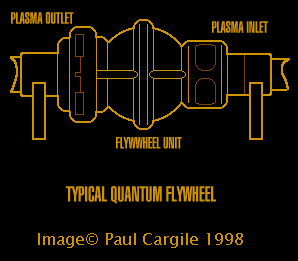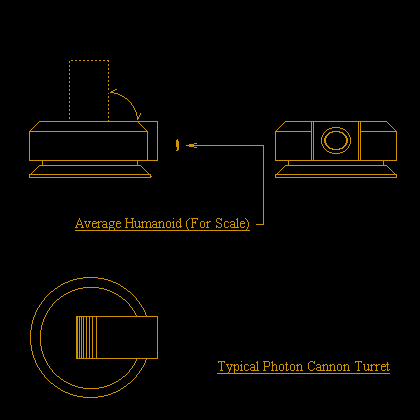First Report of the Vulcan Institute of Very Advanced
Logic, Applied Science, and Various Endeavors of Generally Advanced Studies
(VIVA LAS VEGAS)
New Technology:
Quantum Flywheel
 The quantum flywheel (QF) is an energy storage device, based upon the same
principles that transporter pattern buffers use to compactly store vast
amounts of energy from dematerialized matter. The QF stores plasma energy
in a rapidly rotating quantum field. Adding plasma to the field "speeds
up" the rate of spin, and slowing the rate of spin causes the flywheel
to give off plasma.
The quantum flywheel (QF) is an energy storage device, based upon the same
principles that transporter pattern buffers use to compactly store vast
amounts of energy from dematerialized matter. The QF stores plasma energy
in a rapidly rotating quantum field. Adding plasma to the field "speeds
up" the rate of spin, and slowing the rate of spin causes the flywheel
to give off plasma.
Uses: Quantum flywheels can be used to "smooth out" the energy stream
of power generation systems prone to fluctuating outputs. A small Quantum
flywheel can be used as a "battery" for short-duration vessels, such as
probes. A series of Quantum flywheels can be used to store excess output
from a power source, then augment the power source during higher-than-normal
power consumption, as in combat.
[Special thanks to Paul Cargile for the use of the graphic at right.]
Holographic Hull Projectors
Holographic Hull Projectors (HHP) confer a chameleon-like
ability to adjust hull reflectivity and emissivity. This gives a fair imitation
of cloaking without massive power consumption. This makes a vessel extremely
difficult to detect, and makes a positive weapons lock-on nearly impossible.
It does not, however, confer true cloaking ability. May also be used to
actively display desirable hull markings such as registry numbers, vessel
name or distinctive insignia. HHPs wll not disguise the basic outline of the
vessel.
 Dragon with HHP offline.
Dragon with HHP offline.
|
 Dragon with HHP online.
Dragon with HHP online.
|
Multifunction Phased Arrays
 Multifunction Phased Arrays: Integrated networks of emitters and sensors
imbedded directly within the hull matrix itself. Each array includes sensors,
phaser emitters, navigational deflector emitters, deflector screen emitters,
and tractor beam emitters. Each array can take a significant amount of
damage before performance is noticeably diminished. (The Borg aren't the
only ones who can assimilate new ideas!)
Multifunction Phased Arrays: Integrated networks of emitters and sensors
imbedded directly within the hull matrix itself. Each array includes sensors,
phaser emitters, navigational deflector emitters, deflector screen emitters,
and tractor beam emitters. Each array can take a significant amount of
damage before performance is noticeably diminished. (The Borg aren't the
only ones who can assimilate new ideas!)
Photon Cannon
 The photon cannon was inspired by the phaser cannon. Instead of using a gravity
shell to contain a phaser blast, the photon cannon confines phaser energy
within a subspace containment field. This concentrated "energy packet"
is then fired at a target at subspace radio velocity (approximately 60
billion kilometers per second).
The photon cannon was inspired by the phaser cannon. Instead of using a gravity
shell to contain a phaser blast, the photon cannon confines phaser energy
within a subspace containment field. This concentrated "energy packet"
is then fired at a target at subspace radio velocity (approximately 60
billion kilometers per second).
The photon cannon is a high-powered long-ranged weapon. The amount of
energy confined within the subspace field diminishes by half every
5 seconds, so the effective range is limited by the "muzzle energy". At
a designed maximum power of one terawatt, the energy decays to less than
5 megawatts in ninety seconds of travel, by which time the energy packet
will have travelled nearly 208 light-days (about 5.4 trillion kilometers).
A one-terawatt energy blast decreases to less than one watt within 200 seconds, and poses
no hazard.
This projectile canít change course or velocity, and is totally unaffected
by energy fields. The containment field is destroyed upon contacting a
solid object (such as a ship's hull) or when it finally transforms to ordinary
electromagnetic energy, as all subspace energy does eventually. (The containment
field would be devoid of significant energy by that time and would have
very little effect, if any.) This releases the enclosed photon energy directly
against the object.
Although it requires obscenely accurate fire control,
the two main advantages of the photon cannon are:
- Since the energy packet travels at the same velocity as subspace radio,
the target vessel cannot prepare for any specific blast. By the time sensors
could detect the incoming energy packet, it would be on top of the target.
- The energy packet stays coherent over extremely long distances (over 300
light-days). This extends the range at which a target may be engaged by
a capitol shipís main weapon, but introduces the necessity of either extremely
large target acquisition sensors (to achieve adequate accuracy at range)
or remote target aquisition devices, such as the SARPEV.
†
Go
to VLV2
Return
to VIVA LAS VEGAS main menu
Return
to Top Menu†
 The quantum flywheel (QF) is an energy storage device, based upon the same
principles that transporter pattern buffers use to compactly store vast
amounts of energy from dematerialized matter. The QF stores plasma energy
in a rapidly rotating quantum field. Adding plasma to the field "speeds
up" the rate of spin, and slowing the rate of spin causes the flywheel
to give off plasma.
The quantum flywheel (QF) is an energy storage device, based upon the same
principles that transporter pattern buffers use to compactly store vast
amounts of energy from dematerialized matter. The QF stores plasma energy
in a rapidly rotating quantum field. Adding plasma to the field "speeds
up" the rate of spin, and slowing the rate of spin causes the flywheel
to give off plasma.


 Multifunction Phased Arrays: Integrated networks of emitters and sensors
imbedded directly within the hull matrix itself. Each array includes sensors,
phaser emitters, navigational deflector emitters, deflector screen emitters,
and tractor beam emitters. Each array can take a significant amount of
damage before performance is noticeably diminished. (The Borg aren't the
only ones who can assimilate new ideas!)
Multifunction Phased Arrays: Integrated networks of emitters and sensors
imbedded directly within the hull matrix itself. Each array includes sensors,
phaser emitters, navigational deflector emitters, deflector screen emitters,
and tractor beam emitters. Each array can take a significant amount of
damage before performance is noticeably diminished. (The Borg aren't the
only ones who can assimilate new ideas!) The photon cannon was inspired by the phaser cannon. Instead of using a gravity
shell to contain a phaser blast, the photon cannon confines phaser energy
within a subspace containment field. This concentrated "energy packet"
is then fired at a target at subspace radio velocity (approximately 60
billion kilometers per second).
The photon cannon was inspired by the phaser cannon. Instead of using a gravity
shell to contain a phaser blast, the photon cannon confines phaser energy
within a subspace containment field. This concentrated "energy packet"
is then fired at a target at subspace radio velocity (approximately 60
billion kilometers per second).